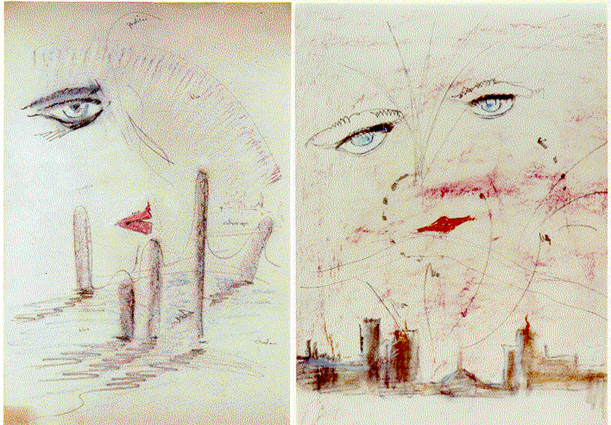book covers we love
Francis Cugat’s striking cover illustration ‘Celestial Eyes’, commissioned for the 1925 edition of The Great Gatsby, is probably one of the most iconic images in literary design history.
 The haunting eyes, painted in gouache, peering out of a deep blue background, float ominously above bright red lips and a glowing cityscape. Each eye features a floating nude – somewhat risqué for the time and perhaps alluding to the seemingly scandalous nature of F. Scott Fitzgerald’s prose.
The haunting eyes, painted in gouache, peering out of a deep blue background, float ominously above bright red lips and a glowing cityscape. Each eye features a floating nude – somewhat risqué for the time and perhaps alluding to the seemingly scandalous nature of F. Scott Fitzgerald’s prose.
Cugat – born Francisco Coradal-Cougat – was relatively unknown when he was give the job in 1924. Fitzgerald was running late with his text and Cugat finished the work, for which he was paid a mere $100, before the novel itself was finished. This resulted in a somewhat unusual collaborative process between the illustrator and author.
‘For Christ’s sake, don’t give anyone that jacket you’re saving for me. I’ve written it into the book,’ Fitzgerald wrote in a letter to his editor Max Perkins in 1924.
There are various theories as to exactly what Fitzgerald meant by this. Some people believe that Cugat intended the eyes to represent Daisy looking down onto the cityscape of New York, while Fitzgerald chose to interpret them in the book itself in the form of the recurring billboard eyes of Dr T. J. Eckleburg.
‘The eyes of Doctor T. J. Eckleburg are blue and gigantic – their retinas are one yard high. They look out of no face, but, instead, from a pair of enormous yellow spectacles which pass over a nonexistent nose,’ Fitzgerald wrote in Chapter 2.
Certainly Scribner agreed that this was the case, commenting, ‘I do not know of another case in which an author acknowledges so central a debt to an illustrator.’
While Fitzgerald loved Cugat’s painting, not everyone agreed with him. In his posthumously published memoir A Moveable Feast (1964), the writer Ernest Hemingway recalled Fitzgerald giving him a copy of The Great Gatsby. Hemingway thought the cover ‘garish’, commenting that it had the look of a ‘bad science fiction’ novel.
‘Scott told me not to be put off by it, that it had to do with a billboard along a highway in Long Island that was important in the story,’ he wrote. ‘He said he had liked the jacket and now he didn’t like it.’
So appalled was Hemingway by the cover that he ‘took it off to read the book.’
Thankfully, most people disagree with Hemingway and Cugat’s jacket illustration commonly makes best cover design lists.
Interestingly, in 2013, following the release of Baz Luhrmann’s remake of The Great Gatsby (sacrilege!) a new edition of the book featuring a film tie-in cover was published. Sales of the Cugat-jacketed edition rocketed.
Today, the original Cugat gouache artwork forms part of the Princeton University Library for the Graphic Arts Collection and was donated by Charles Scribner III. He inherited it from his cousin, George Schieffelin, who discovered it in a bin comprising publishing ‘dead matter’.
He very sensibly took it home.
Images: The original gouache painting produced by Cugat (1924); early sketches for the jacket by Cugat (1924); the full jacket of the first edition published by Scribner in 1925.
Book covers we love: Ralph Ellison’s Invisible Man by E. McNight Kauffer (1952); Dorothy L. Sayers’ Busman’s Honeymoon by Romek Marber (1963); Georgette Heyer’s Frederica – Arthur Barbosa (1965).
See also: ‘Presenting Ms Georgette Heyer‘ and ‘Books that changed my life’ boards, both Pinterest; articles: ‘How Penguin learned to fly – Allen Lane and the Original Penguin 10‘; ‘Romek Marber’.
‘Pinterest – “inspiration snacking” or something more? A few tips for authors‘.
Notice: Please note the images and quotations included in this article are for promotional purposes only and are intended as a homage to the designers, artists and writers cited. In no way, have we have intentionally breached anyone’s copyright. If you believe otherwise, please contact us and we will take down any text/images as appropriate.
This article is ©The Literary Shed, 2015. All opinions are our own. Please only reproduce it with our permission and credit us appropriately. Please contact us if you wish to do so.



